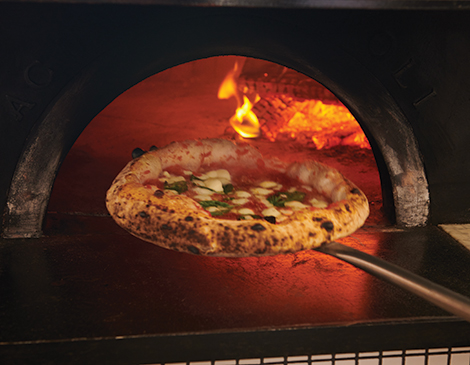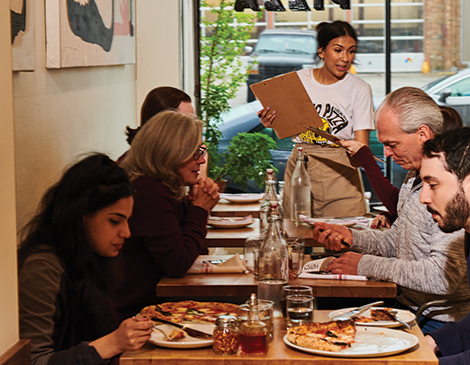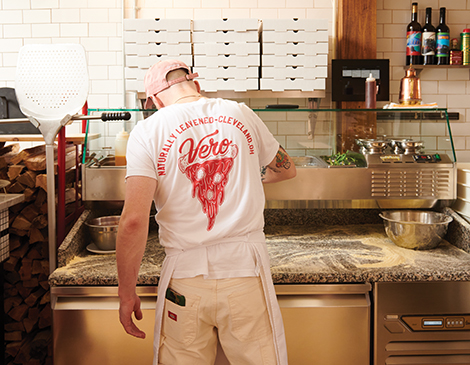There was a time when Marc-Aurele Buholzer, the pizzaiolo of Vero Pizzeria Napoletana, didn’t love pizza. He actively disliked it.
“Back then, Europeans had a different idea of good food than Americans did, and American pizza was all chain restaurants,” says Buholzer, who was born in Switzerland and grew up in Chardon. “Nothing against those places, but it wasn’t what I liked.”
At age 23, though, Buholzer’s pizza perspective was turned upside down. By 2007, Buholzer had been working at Cleveland Heights’ now defunct La Gelateria on and off for eight years. Even the best gelato was a tough sell during frigid Cleveland winters. To supplement the slow season, the owner purchased a wood-fired oven for making Neapolitan-style pizzas. The upscale pizza craze had yet to hit Northeast Ohio, which made the Italian-inspired pies a novelty — and, for Buholzer, a revelation.
“I was introduced to this pizza with fresh toppings: nice herbs and cheese, the most wonderful tomatoes from Italy, a very simple sauce without sugar,” he recalls. “I absolutely loved it.”

Megann Galehouse
One Friday, the pizza maker quit, leaving the shop in a lurch. Buholzer, who had been quietly observing the pizza-making process, assumed the role. Though he made just 25 pizzas per day, it was a grueling weekend of work — trial by wood fire, if you will. Buholzer found it exhilarating.
“I’d entered into something that is not immediately understood, gained and accomplished,” he says. “I started seeing all the nuances in the process and recognizing that there was more for me to figure out.”
When La Gelateria closed in 2012, Buholzer opened his own restaurant in the space. The original wood-fired oven remained. The name, Vero, is Italian for “true” or “real” — an homage to authenticity in his craft.
Though Vero isn’t a member of the Associazione Verace Pizza Napoletana, an Italian association that defines what can be considered Neapolitan pizza, Buholzer is a stickler for its standards. Dough must be made of water, yeast, salt and Italian flour. Tomatoes must be San Marzano or piennolo, a varietal that grows in the soil of Mount Vesuvius. The only acceptable cheeses are Buffalo mozzarella or cow’s milk mozzarella (fior di latte, in Italian). Importantly, Neapolitan pizza is also cooked at high heat — very high heat, up to 900 degrees Fahrenheit. “A whole different magic occurs because of the high heat,” Buholzer says. “The flour reacts differently; the level of water starts changing the way it’s growing. You’re putting the dough on a stage that will very quickly show you any error in your formula.”
In 2021, when Vero closed for takeout-only pandemic service, Buholzer upgraded to a 6,000-pound Acunto, an imported Italian oven made for cooking Neapolitan pizza. Custom-designed in Naples, Buholzer’s boasts “Vero” in custom black-and-white Venetian ceramic tile work, and the building had to be partially remodeled to fit it.
It was worth it, though, allowing Buholzer to level up his skill set. It also paved the way for a bigger Vero expansion in 2024, one that doubled seating capacity and added a beautiful marble bar (plus a full liquor license).
Vero’s pizzas are papery thin in the middle, surrounded by a puffy, raised crust called a cornicione. The dough has taken Buholzer more than a decade to perfect. He uses non-GMO European flour and a ratio of nearly 80% hydration. The wet dough can be tricky to handle. He also rejects commercial yeast, turning to a long-cultivated SCOBY — a culture of bacteria and yeast that breaks down complex carbohydrates and makes the dough lighter.
“High hydration and natural leavening both help aid in easier-to-digest dough,” Buholzer says. “That’s why, after you eat my dough, you don’t feel heavy an hour later.”
Vero’s pizza menu is divided up simply: tomato-based and white. There are the Neapolitan classics, like two versions of Margherita ($24 and $26) and a bianca with just garlic, mozzarella and fresh basil ($22). Somehow, though, all of Buholzer’s pies seem like Old World Italian classics, even when he goes for variation with offerings like the Oro Affumicato (“smoked gold”), featuring yellow tomatoes and a smoky provolone. Another perpetual favorite, the Milk and Honey ($26), includes a farm egg and a drizzle of hot honey; one online reviewer observed with awe that eating it was “like having breakfast, lunch and dessert at the same time.”

Megann Galehouse
It’s not hard to see why the restaurant’s regulars have been coming to Vero since Buholzer’s time at the gelato shop. The quality has never faltered. Singularly focused and never bored, Buholzer cherishes the opportunity to keep growing in his craft — and he welcomes the challenge.
“I find myself in the process of making the dough, in the process of experimenting, in the process of repetition,” Buholzer says. “If you consider what monks do … it’s just repetition, whether it be repeating a mantra, a prayer, a routine or an activity. It’s that repetition that allows us to start breathing a little more freely.”
Dive deep into Cleveland's pizza scene with our November 2024 Pizza Issue.
For more updates about Cleveland, sign up for our Cleveland Magazine Daily newsletter, delivered to your inbox six times a week.
Cleveland Magazine is also available in print, publishing 12 times a year with immersive features, helpful guides and beautiful photography and design.




